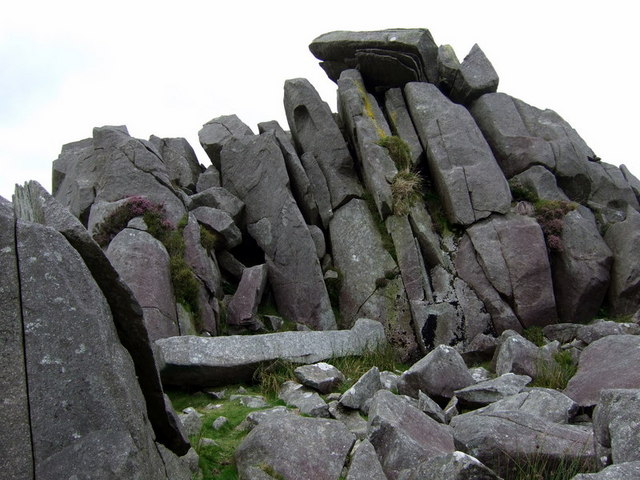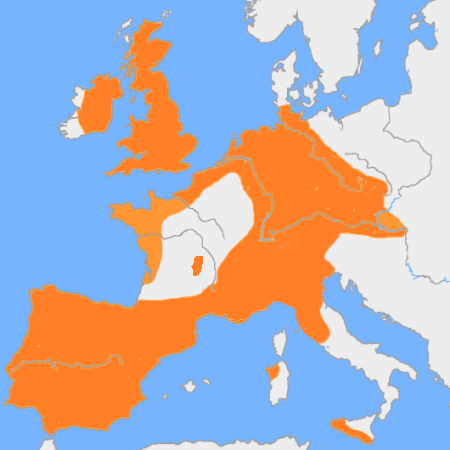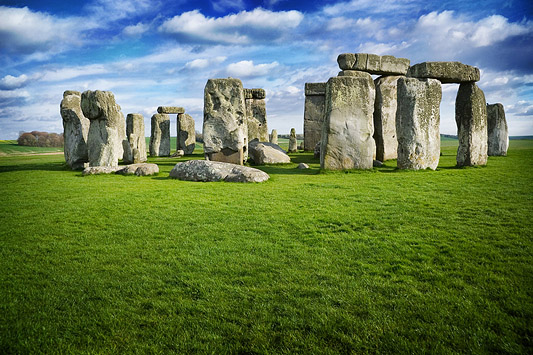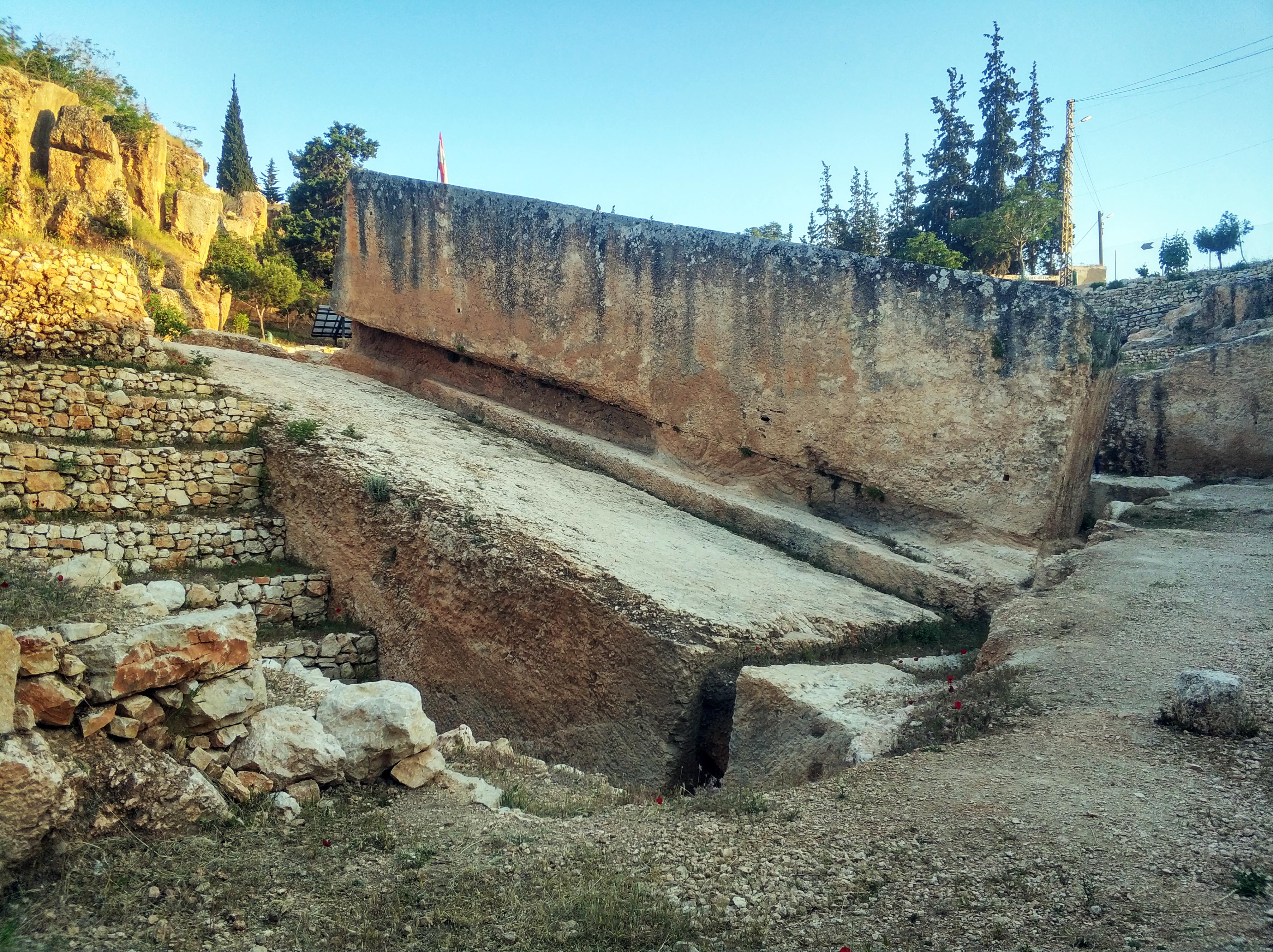|
Stonehenge
Stonehenge is a prehistoric Megalith, megalithic structure on Salisbury Plain in Wiltshire, England, west of Amesbury. It consists of an outer ring of vertical sarsen standing stones, each around high, wide, and weighing around 25 tons, topped by connecting horizontal lintel stones, held in place with mortise and tenon joints, a feature unique among contemporary monuments. Inside is a ring of smaller bluestones. Inside these are free-standing trilithons, two bulkier vertical sarsens joined by one lintel. The whole monument, now ruinous, is aligned towards the sunrise on the summer solstice and sunset on the winter solstice. The stones are set within Earthwork (archaeology), earthworks in the middle of the densest complex of Neolithic British Isles, Neolithic and Bronze Age Britain, Bronze Age monuments in England, including several hundred ''tumuli'' (burial mounds). Stonehenge was constructed in several phases beginning about 3100 BC and continuing until about 1600 B ... [...More Info...] [...Related Items...] OR: [Wikipedia] [Google] [Baidu] |
Stonehenge, Avebury And Associated Sites
Stonehenge, Avebury and Associated Sites is a UNESCO World Heritage Site (WHS) in Wiltshire, England. The WHS covers two large areas of land separated by about , rather than a specific monument or building. The sites were inscribed as co-listings in 1986. Some large and well known monuments within the WHS are listed below, but the area also has an exceptionally high density of small-scale archaeological sites, particularly from the prehistoric period. More than 700 individual archaeological features have been identified. There are 160 separate scheduled monuments, covering 415 items or features. Stonehenge and associated monuments The Stonehenge area of the WHS is in south Wiltshire. It covers an area of 26 square km and is centred on the prehistoric monument of Stonehenge. Ownership is shared between English Heritage, the National Trust, the Ministry of Defence, the RSPB, Wiltshire Council, and private individuals and farmers. Monuments in the Stonehenge WHS *Stonehenge * St ... [...More Info...] [...Related Items...] OR: [Wikipedia] [Google] [Baidu] |
Bluestone
Bluestone is a cultural or commercial name for a number of natural dimension stone, dimension or building stone varieties, including: * basalt in Victoria (Australia), Victoria, Australia, and in New Zealand * diabase, dolerites in Tasmania, Australia; and in Britain (including Stonehenge) * feldspar, feldspathic sandstone in the US and Canada * limestone in the Shenandoah Valley in the US, from the Hainaut (province), Hainaut quarries in Soignies, Belgium, and from quarries in County Carlow, County Galway and County Kilkenny in Ireland * slate in South Australia It is unrelated to human-made blue brick. Stonehenge The term "bluestone" in Britain is used in a loose sense to cover all of the "foreign", not intrinsic, stones and rock debris at Stonehenge. It is a "convenience" label rather than a geological term, since at least 46 different rock types are represented. One of the most common rocks in the assemblage is known as Preseli spotted dolerite—a chemically altered i ... [...More Info...] [...Related Items...] OR: [Wikipedia] [Google] [Baidu] |
Bronze Age Britain
Bronze Age Britain is an era of British history that spanned from until . Lasting for approximately 1,700 years, it was preceded by the era of Neolithic Britain and was in turn followed by the period of Iron Age Britain. Being categorised as the Bronze Age, it was marked by the use of copper and then bronze by the prehistoric Britons, who used such metals to fashion tools. Great Britain in the Bronze Age also saw the widespread adoption of agriculture. During the British Bronze Age, large megalithic monuments similar to those from the Late Neolithic continued to be constructed or modified, including such sites as Avebury, Stonehenge, Silbury Hill and Must Farm. That has been described as a time "when elaborate ceremonial practices emerged among some communities of subsistence agriculturalists of western Europe". History Early Bronze Age (EBA), c. 2500–1500 BC There is no clear consensus on the date for the beginning of the Bronze Age in Great Britain and Ireland. Some ... [...More Info...] [...Related Items...] OR: [Wikipedia] [Google] [Baidu] |
Amesbury
Amesbury () is a town and civil parish in Wiltshire, England. It is known for the prehistoric monument of Stonehenge which is within the parish. The town is claimed to be the oldest occupied settlement in Great Britain, having been first settled around 8820 BC. The parish includes the hamlets of Ratfyn and West Amesbury, and part of Boscombe Down military airfield. Etymology The derivation of the name of the town is uncertain. It may derive from an Anglo-Saxon named ''Ambre'', or from the Old English ''amore-burh'' meaning 'fortification frequented by buntings or/and yellowhammers'. It has also been suggested that the name is derived from Ambrosius Aurelianus, leader of Romano-British resistance to Saxon invasions in the 5th century. Geography Amesbury is located in southern Wiltshire, north-northeast of Salisbury on the A345. It sits in the River Avon valley on the southern fringes of Salisbury Plain and has historically been considered an important river crossing area o ... [...More Info...] [...Related Items...] OR: [Wikipedia] [Google] [Baidu] |
Megalith
A megalith is a large stone that has been used to construct a prehistoric structure or monument, either alone or together with other stones. More than 35,000 megalithic structures have been identified across Europe, ranging geographically from Sweden in the north to the Mediterranean Sea in the south. The word was first used in 1849 by the British antiquarian Algernon Herbert in reference to Stonehenge and derives from the Ancient Greek words " mega" for great and " lithos" for stone. Most extant megaliths were erected between the Neolithic period (although earlier Mesolithic examples are known) through the Chalcolithic period and into the Bronze Age. Types and definitions While "megalith" is often used to describe a single piece of stone, it also can be used to denote one or more rocks hewn in definite shapes for special purposes. It has been used to describe structures built by people from many parts of the world living in many different periods. The most widely known ... [...More Info...] [...Related Items...] OR: [Wikipedia] [Google] [Baidu] |
English Heritage
English Heritage (officially the English Heritage Trust) is a charity that manages over 400 historic monuments, buildings and places. These include prehistoric sites, a battlefield, medieval castles, Roman forts, historic industrial sites, Listed building, listed ruins, and architecturally notable English country houses. The charity states that it uses these properties to "bring the story of England to life for over 10 million people each year". Within its portfolio are Stonehenge, Dover Castle, Tintagel Castle, and the "best-preserved" parts of Hadrian's Wall. English Heritage also manages the London blue plaque scheme, which links influential historical figures to particular buildings. When originally formed in 1983, English Heritage was the operating name of an executive non-departmental public body of the Her Majesty's Government, British Government, officially titled the Historic Buildings and Monuments Commission for England, that ran the national system of heritage prot ... [...More Info...] [...Related Items...] OR: [Wikipedia] [Google] [Baidu] |
Trilithon
A trilithon or trilith is a structure consisting of two large vertical stones (posts) supporting a third stone set horizontally across the top ( lintel). It is commonly used in the context of megalithic monuments. The most famous trilithons are those of Stonehenge in England. The word ''trilithon'' is derived from Greek 'having three stones' (τρι- ''tri-'' 'three' + λίθος ''líthos'' 'stone') and was first used in its modern archaeological sense by William Stukeley. Other famous trilithons include those found in the Megalithic temples of Malta (which like Stonehenge are a UNESCO World Heritage Site), the Osireion in Egypt, and the Haʻamonga ʻa Maui in Tonga, Polynesia. The term is also used to describe the groups of three stones in the Hunebed tombs of the Netherlands. See also * Dolmen * Henge * Megalithic architectural elements * Menhir A menhir (; from Brittonic languages: ''maen'' or ''men'', "stone" and ''hir'' or ''hîr'', "long"), standing st ... [...More Info...] [...Related Items...] OR: [Wikipedia] [Google] [Baidu] |
Sarsen
Sarsen stones are silicification, silicified sandstone blocks found extensively across southern England on the Salisbury Plain and the Marlborough Downs in Wiltshire; in Kent; and in smaller quantities in Berkshire, Essex, Oxfordshire, Dorset, and Hampshire. Geology Sarsen stones are the post-glacial remains of a cap of Cenozoic silcrete that once covered much of southern England. This is thought to have formed during Neogene to Quaternary weathering by the silicification of Upper Paleocene Lambeth Group sediments, resulting from acid leaching. Etymology There are several potential sources for the word "sarsen." The first is that word "sarsen" is a shortening of "Saracen stone" which arose in the Wiltshire dialect. In the Middle Ages, "Saracen" was a common name for Muslims, and came by extension to be used for anything regarded as non-Christian, whether Muslim or pagan in contrast to Christianity. The second is that "sarsen" is vernacular variation of the Indo-European "sasan ... [...More Info...] [...Related Items...] OR: [Wikipedia] [Google] [Baidu] |
Winter Solstice
The winter solstice, or hibernal solstice, occurs when either of Earth's geographical pole, poles reaches its maximum axial tilt, tilt away from the Sun. This happens twice yearly, once in each hemisphere (Northern Hemisphere, Northern and Southern Hemisphere, Southern). For that hemisphere, the winter solstice is the day with the shortest daytime, period of daylight and longest night of the year, and when the Sun is at its lowest culmination, daily maximum elevation in the sky. Each Polar Circle, polar region experiences polar night, continuous darkness or twilight around its winter solstice. The opposite event is the summer solstice. The winter solstice occurs during the hemisphere's winter. In the Northern Hemisphere, this is the December solstice (December 21 or 22) and in the Southern Hemisphere, this is the June solstice (June 20 or 21). Although the winter solstice itself lasts only a moment, the term also refers to the day on which it occurs. Traditionally, in many Tem ... [...More Info...] [...Related Items...] OR: [Wikipedia] [Google] [Baidu] |
Sarsen
Sarsen stones are silicification, silicified sandstone blocks found extensively across southern England on the Salisbury Plain and the Marlborough Downs in Wiltshire; in Kent; and in smaller quantities in Berkshire, Essex, Oxfordshire, Dorset, and Hampshire. Geology Sarsen stones are the post-glacial remains of a cap of Cenozoic silcrete that once covered much of southern England. This is thought to have formed during Neogene to Quaternary weathering by the silicification of Upper Paleocene Lambeth Group sediments, resulting from acid leaching. Etymology There are several potential sources for the word "sarsen." The first is that word "sarsen" is a shortening of "Saracen stone" which arose in the Wiltshire dialect. In the Middle Ages, "Saracen" was a common name for Muslims, and came by extension to be used for anything regarded as non-Christian, whether Muslim or pagan in contrast to Christianity. The second is that "sarsen" is vernacular variation of the Indo-European "sasan ... [...More Info...] [...Related Items...] OR: [Wikipedia] [Google] [Baidu] |
Wiltshire
Wiltshire (; abbreviated to Wilts) is a ceremonial county in South West England. It borders Gloucestershire to the north, Oxfordshire to the north-east, Berkshire to the east, Hampshire to the south-east, Dorset to the south, and Somerset to the west. The largest settlement is Swindon, and Trowbridge is the county town. The county has an area of and a population of 720,060. The county is mostly rural, and the centre and south-west are sparsely populated. After Swindon (183,638), the largest settlements are the city of Salisbury (41,820) and the towns of Chippenham (37,548) and Trowbridge (37,169). For local government purposes, the county comprises two unitary authority areas: Swindon and Wiltshire. Undulating chalk downlands characterize much of the county. In the east are Marlborough Downs, which contain Savernake Forest. To the south is the Vale of Pewsey, which separates the downs from Salisbury Plain in the centre of the county. The south-west is also downland, ... [...More Info...] [...Related Items...] OR: [Wikipedia] [Google] [Baidu] |







